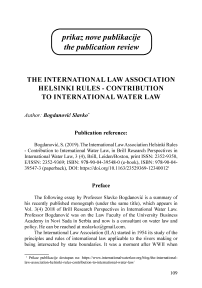Bogdanović, S. (2019). The International Law Association Helsinki Rules - Contribution to International Water Law, in Brill Research Perspectives in International Water Law, 3 (4), Brill, Leiden/Boston
Автор: Slavko Bogdanović
Журнал: Pravo - teorija i praksa @pravni-fakultet
Рубрика: Review paper
Статья в выпуске: 1-3 vol.36, 2019 года.
Бесплатный доступ
Короткий адрес: https://sciup.org/170202280
IDR: 170202280
Текст статьи Bogdanović, S. (2019). The International Law Association Helsinki Rules - Contribution to International Water Law, in Brill Research Perspectives in International Water Law, 3 (4), Brill, Leiden/Boston
Author: Bogdanović Slavko*
Bogdanović, S. (2019). The International Law Association Helsinki Rules - Contribution to International Water Law, in Brill Research Perspectives in International Water Law, 3 (4), Brill, Leiden/Boston, print ISSN: 2352-9350, E/ISSN: 2352-9369; ISBN: 978-90-04-39548-0 (e-book), ISBN: 978-90-0439547-3 (paperback), DOI:
Preface
The International Law Association (ILA) started in 1954 its study of the principles and rules of international law applicable to the rivers making or being intersected by state boundaries. It was a moment after WWII when the enhanced harnessing of hydropower potential of international rivers was seen as a necessity. The rising development needs of nations in parallel with growth of populations resulted in enlarging demand for electric energy production. Engineering aspects of harnessing rivers were not the problem; the challenge was the applicable law. The lack of accepted and pertinent international law rules was a major obstacle not only forthe economic development of nations, but also to the economy of the world in general.
Early in the last century, the Geneva Convention relating to Development of Hydraulic Power affecting more than one State (1923) andother (scarce) sources of international water lawhad shown their limits and inadequacy not only for resolving pending developmental problems, but also for addressing serious interstate disputes concerning the rights of upstream and downstream states to the waters of international rivers(some of the more well-known disputes included the Helmand, Indus, Nile, Jordan and Yarmouk, and Columbia rivers). At the time, the U.N. International Law Commission was not willing to deal with the issue of codification of the applicable law considering it to be premature.
In the United Nations system, the problem was identified and investigated-beginning in the late 1940s, and addressed continually through the 1990s when long-lasting efforts by different bodies and agencies finally resulted in the adoption of the UN Convention on the Law of Non-navigational Uses of International Watercoursesin 1997.
The Publication Review
This monograph is the result of research aimed at highlighting the details of the initial period of the ILA’s effortsto respond to the situ-ation.Its Rivers Committee wasassi-gnedin 1954 “to study the various legal, economic and technical aspects of rights and obligations between states as to the inland waters, [...] with the purpose of elaborating practical recommendations for international arrangement”. Besides a review of the broader context in

BRP
The International Law Association Helsinki Rules
Contribution to International Water Law
Slavko Bogdanović
which the ILA efforts and activities were situated, the monograph is focused on detailed elaboration and analysis of the documents drafted by the Rivers Committee, which, under the strong supervision and precise guidelines of the management bodies of the ILA, led step-by-step to the approval of the famous Helsinki Rules on the Uses of the Waters of International Riversin 1966. This is followed by a discussion about the Helsinki Conference and its resolution, and then a detailed analysis of each chapter of the Helsinki Rules. The concluding part of the monograph highlights the global acceptance and wide influence exerted by the Helsinki Rules on shared water resources and related disputes, inparticular the UN Watercourses Convention.
The monograph points out that the Helsinki Rules were neither ideal nor complete. As a “delicate balance between widely divergent views”, the Helsinki Rules were subject to the scrutiny of two subsequent ILA committees, which were active until 2004. Those committees studied various topics and formulated a series of articles supplementary and complementary to the Helsinki Rules with theaim of updating, upgrading and revising certain details. In that way, the Helsinki Rules served as reliable ground for further exhaustive study in this field, what eventually resulted in the comprehensive and consistent set of ILA rules compiled in the Campione Consolidation of the Rules on International Water Resources, 1996 – 1999 (2000).
The monograph also briefly indicated the attempt of the ILA to revise its entire body of international water law compiled in the Campione Consolidation, through approval of the Berlin Rules on Water Resources (2004), which diverge substantially from the key principles as set out in the Helsinki Rules and all other ILA rules subsequently approved, and from the final output of the International Law Commission on the law of non-navigational uses of international watercourses (1966), the UN Watercourses Convention (1997), and from the ICJ judgment in the Case concerning the Gabčikovo – Nagymaros Project (1997) (see Berlin Rules Dissenting Opinion).
Finally, the monograph calls for further investigation and critical analysis and evaluation of the entire body of work by the ILA in the field of international water law, including the outputsof two later ILA committees and the background leading to the approval of the Berlin Rules. The author argued that such research might show thatthe Helsinki Rules, in the advanced, revised and enriched form, expressed in the Campione Consolidation, are a safe pivot, marking the way out from the confusion caused by emerging proliferation of wishful concepts and ideas in this still young branch of international law.
The monograph is dedicated to the memory of Dr Dante Caponera (19212003), and the other members and officers of the ILA Rivers Committee.


